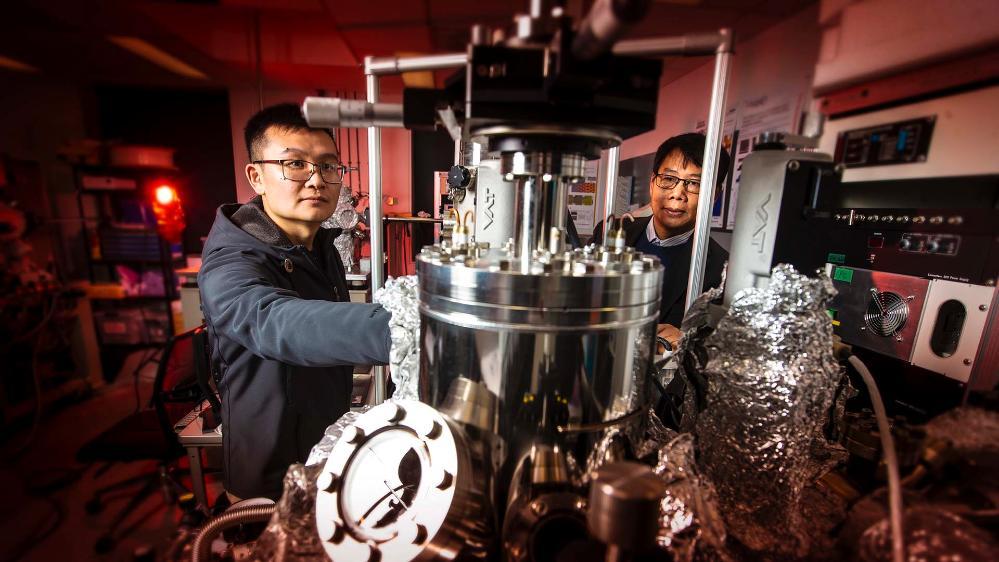May 25, 2020
Interfaces the key in atomically thin, high-temperature superconductors
Discovery could unlock elusive mechanism behind high-temperature superconductivity.
A review of atomically thin high-temperature superconductors has found that each has a common driving mechanism: interfaces.
The review was conducted by a team from the ARC Centre of Excellence in Future Low-Energy Electronics Technologies (FLEET), including researchers from the University of Wollongong (UOW), Monash University, and Tsinghua University (Beijing). It found that interfaces between materials were the key to superconductivity in all systems examined.
Thestudy was led by Dr Zhi Li from UOW's Institute for Superconducting and Electronic Materials (ISEM) (pictured above with co-author Senior Professor Xiaolin Wang).
The enhancement of superconductivity at interfaces (interface superconductivity enhancement effect) in atomically thin superconductors is a unique tool for discovering new high-temperature superconductors, and could be used to finally unlock the elusive mechanism behind high-temperature superconductivity.
Systems studied include:
- elemental metals grown on semiconductors
- single-layer iron-based superconductors
- atomically-thin cuprate (copper based) superconductors
The review investigated the role of molecular-beam epitaxy (MBE), scanning tunnelling spectroscopy (STM/STS), scanning transmission electron microscopy (STEM), physical properties measurement system (PPMS), in fabricating and identifying atomically thin superconductors.
Superconductors: A background
Atomically thin superconductors (whether iron based or copper based) are a type of high temperature (Type II or unconventional) superconductor in that they have a transition temperature (Tc) much higher than a few degrees Kelvin above absolute zero.
The driving force behind such Type II superconductors has remained elusive since their discovery in the 1980s. Unlike conventional superconductors, it is clear they cannot be directly understood from the Bardeen, Cooper, and Schrieffer electron-phonon coupling theory.
In successive discoveries, the transition temperature has been driven steadily higher, and in the last decade there has been significant advances in the use of atomically thin superconductors, both iron- and copper-based.
These new discoveries challenge current theories regarding the superconducting mechanism of unconventional superconductors and indicate promising new directions for realising high transition temperature superconductors.
“The ultimate goal of the research of superconductivity is finding superconductors with a superconducting transition temperature at or higher than room temperature,” Dr Li said.
The study
The review paper Atomically thin superconductors was published in the journal Small in May 2020 (DOI 10.1002/smll.201904788).
The authors acknowledge support from the Australian Research Council via the Centre of Excellence, Discovery and Future Fellowship programs.
The review investigated the role of molecular-beam epitaxy (MBE), scanning tunnelling spectroscopy (STM/STS), scanning transmission electron microscopy (STEM), physical properties measurement system (PPMS), in fabricating and identifying atomically thin superconductors.
Novel materials study at FLEET
The properties of novel, atomically thin materials are studied at FLEET, an Australian Research Council Centre of Excellence, within the Centre’s Enabling technology A.
The Centre for Future Low-Energy Electronics Technologies (FLEET) is a collaboration of over a hundred researchers, seeking to develop ultra-low energy electronics to face the challenge of energy use in computation, which already consumes 8% of global electricity, and is doubling each decade.
Each of FLEET’s three research themes are heavily enabled by these novel materials, including 2D topological materials (Research Theme 1), atomically thin semiconductors (as hosts for excitons in Research Theme 2, and for realising non-equilibrium topological phenomena in Research Theme 3).
